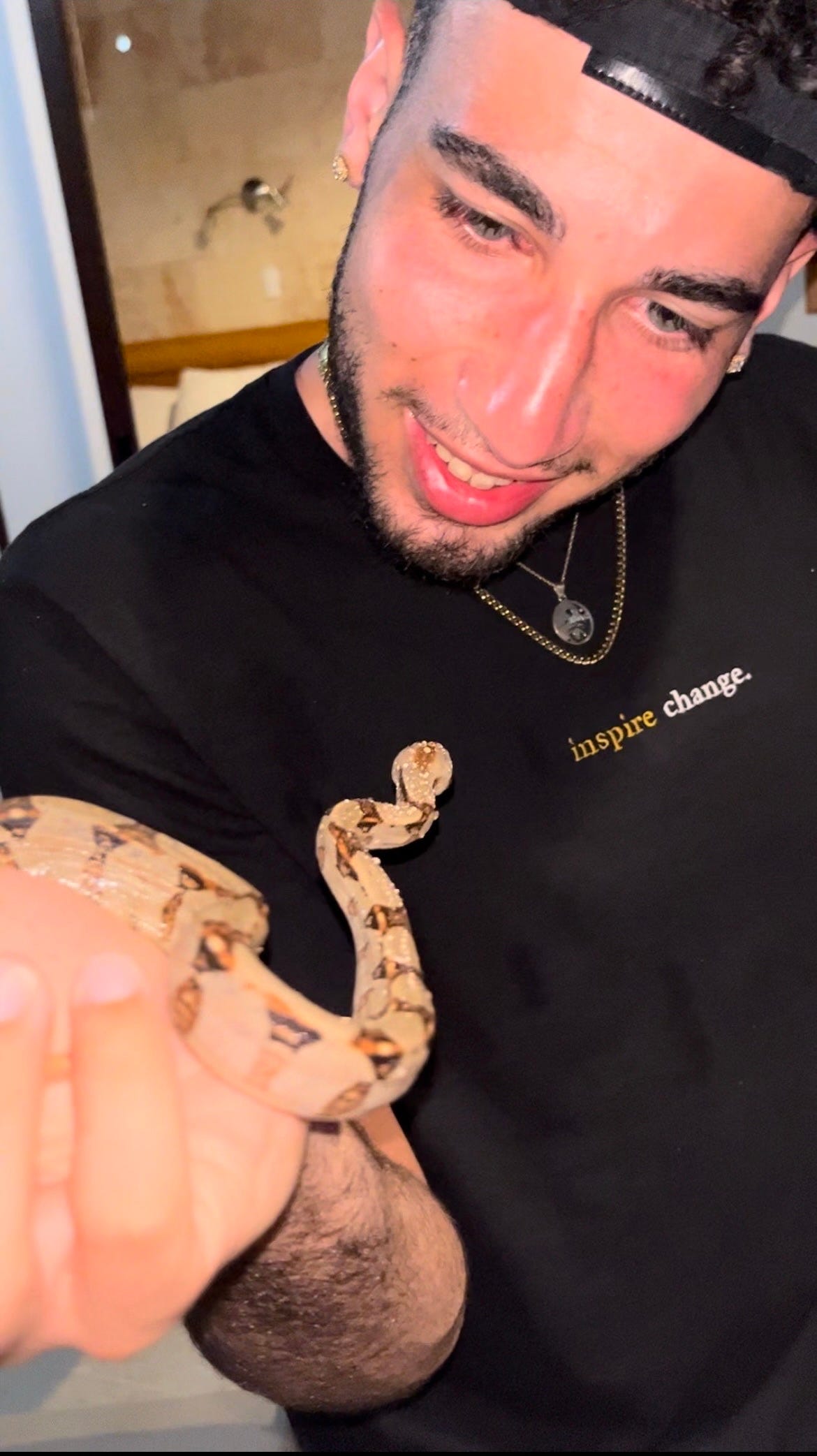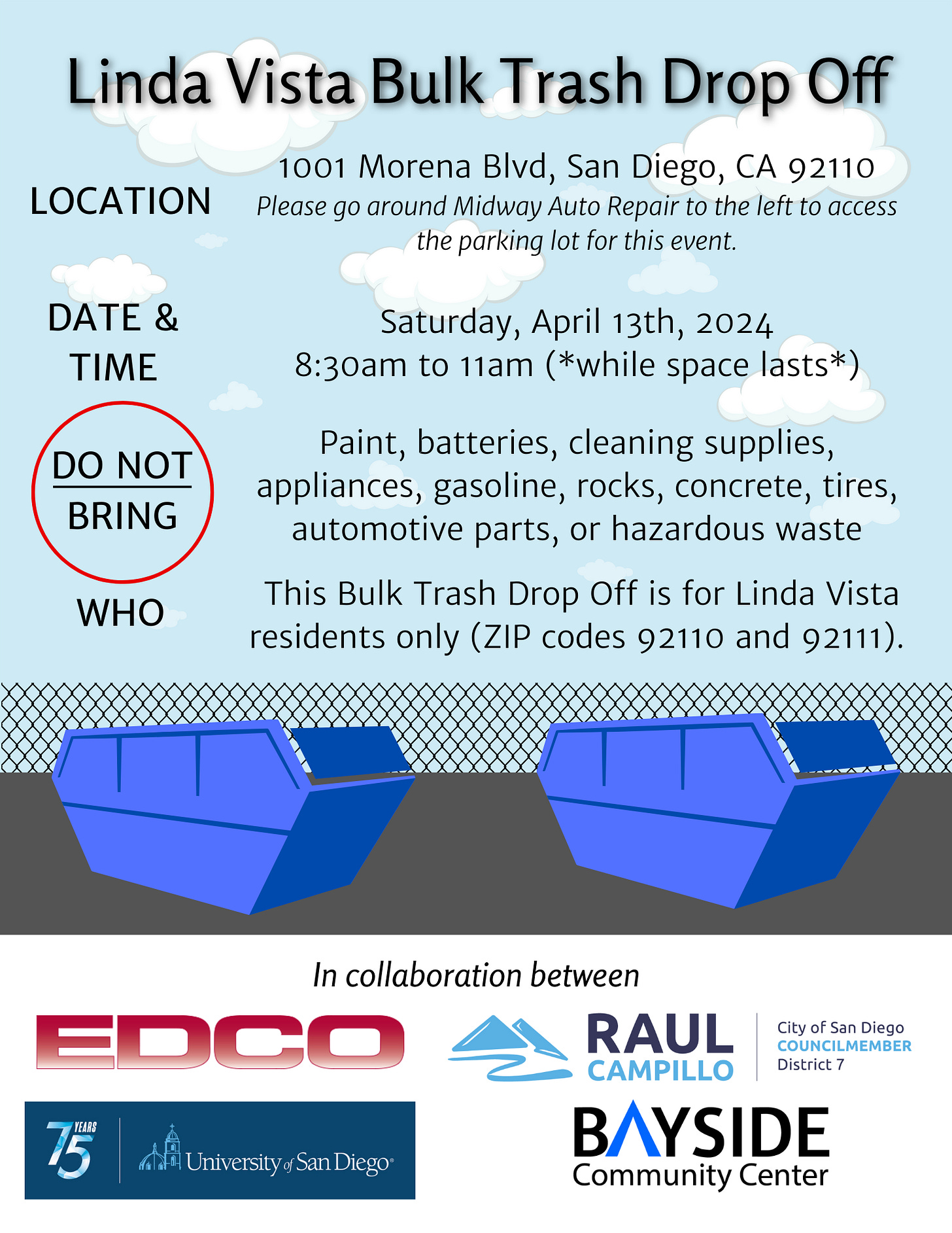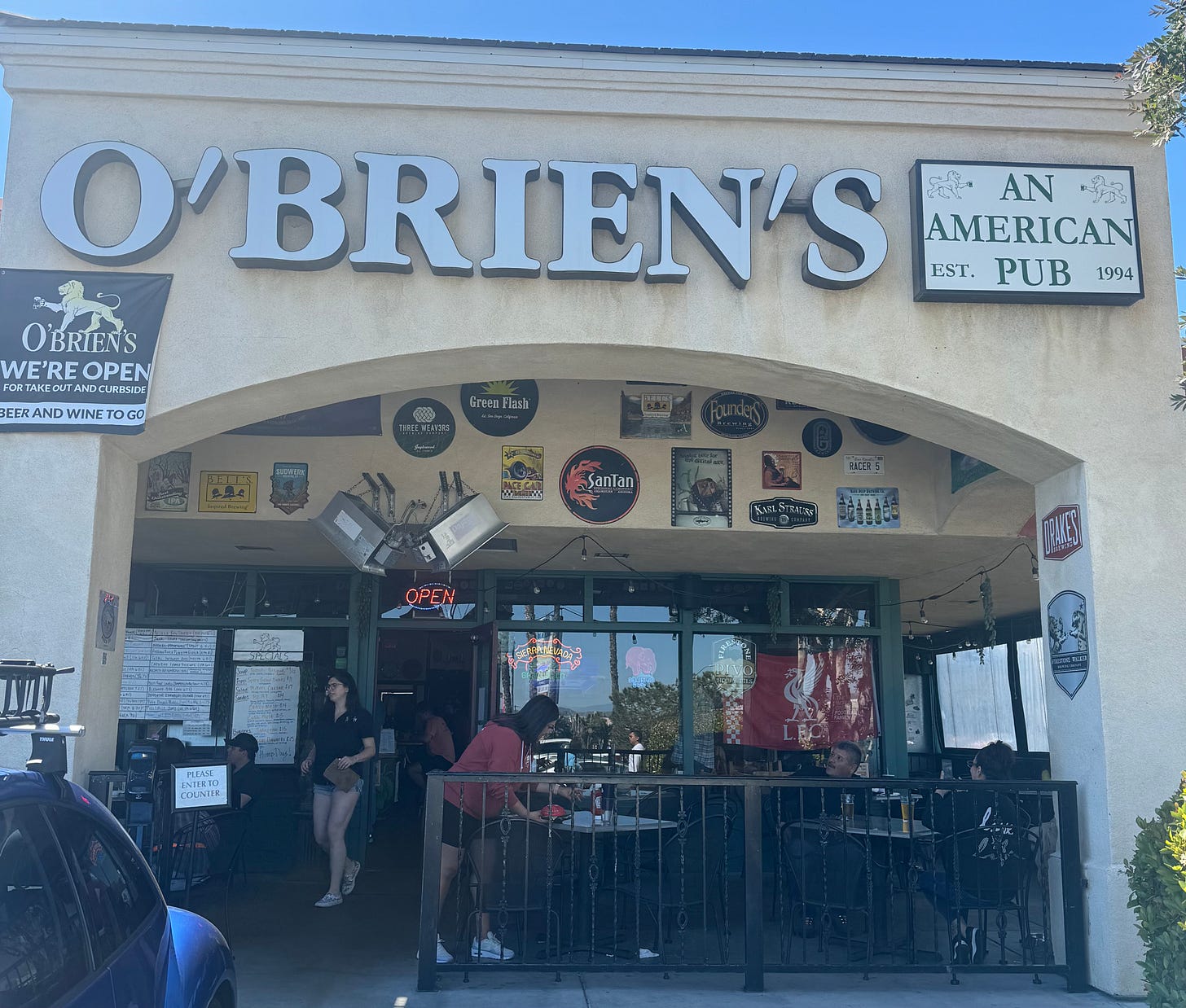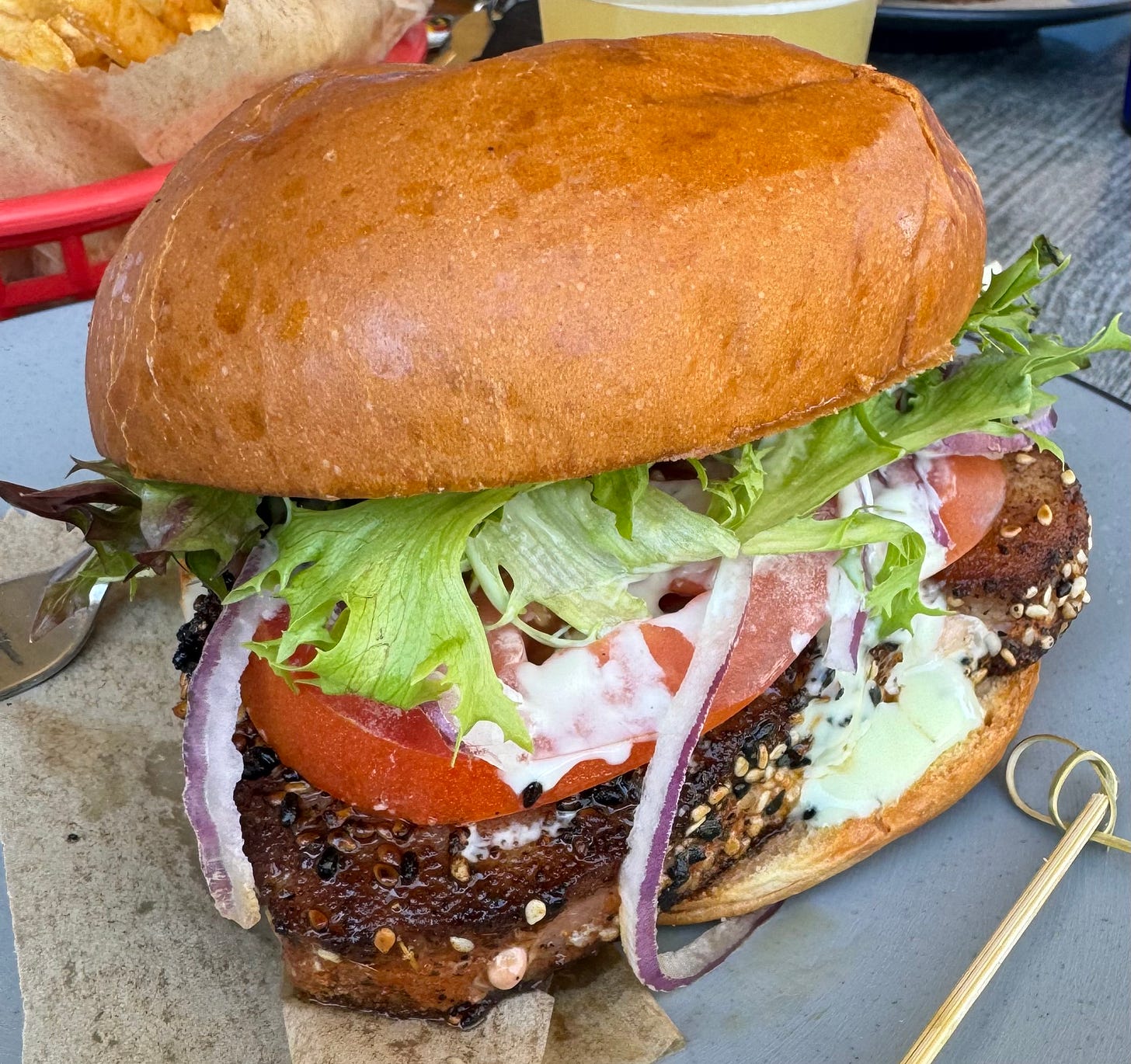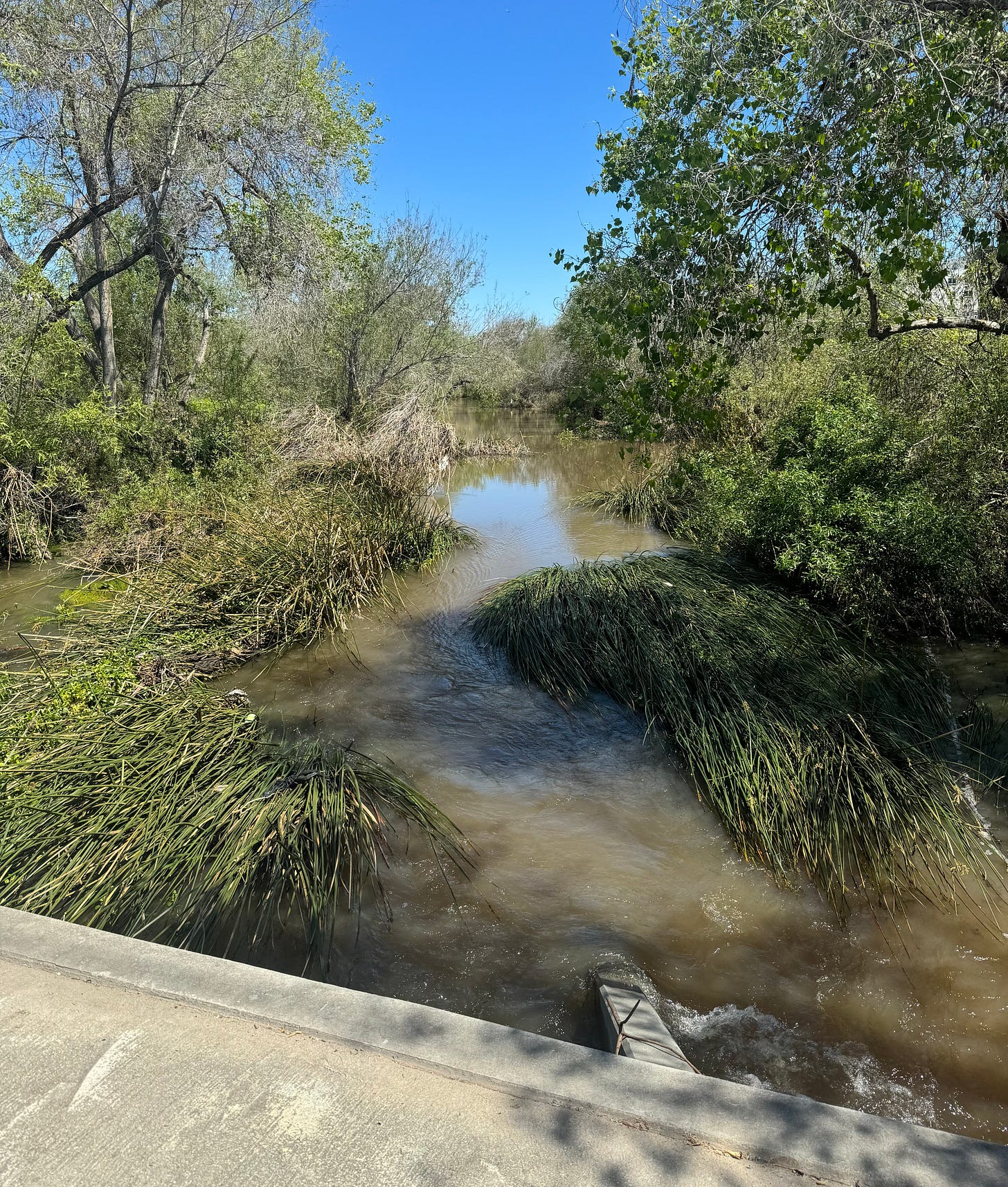Got Snakes in LV? Who You Gonna Call?
Plus: Bulk Trash Pick Up Annoucement, O'Brien's Pub on Convoy, Commentary on Road Resurfacing Recommendation, and LV Poetry Corner
While perusing the social media site Nextdoor, we came across an interesting post from local area resident Grayson Walker; he identified himself as a snake handler capable of removing snakes from residences/yards. The post showed him in action on video footage bravely removing a rattlesnake located next to a house. We thought he might make for an interesting story for this newsletter, and that he might be someone whose services our readers might someday need. Accordingly, we asked him to answer a few questions for us. Of course, this snake handler had an interesting story to tell. Here is what he had to say.
— How long have you worked as a snake handler?
I have been working with snakes nearly my whole life. I caught my first snake when I was 4 years old in the mountains of Golden, Colorado where I grew up. Now, 20 years later, after getting a master’s degree, playing professional basketball, and starting a career in business, I have been professionally trained to handle venomous snakes and have been doing rescue and relocation for the past year in San Diego.
—Do you work as a snake handler as a business/service? If so, how much do you charge? What is the name of your business, or the business/institution you work for?
I work both alone as a free, donation-based service to the community I live in and as part of three of the premier snake organizations in the area. I don't believe that cost should be a barrier to having a snake safely relocated, and would never want to put someone in a situation where they felt that it made more sense to kill a snake rather than pay a fee for its humane relocation. Tips and donations from those who are able are greatly appreciated, though, and help cover my gas and equipment costs. I am proud to work with the Snake Wranglers, a volunteer group out of North County led by my good friend and mentor Bruce Ireland, SoCal Rattlesnake Removal, a licensed business led by Alex Trejo which serves the entire region, and local legend Trapper Pat in Poway.
How did you become a snake handler? Did you receive training from someone or some institution?
Like I said, I have been working with snakes since I was 4 years old. I aspired to be a herpetologist and studied everything there was to know about snakes at a young age, before being pulled in a different direction in school and life. I reconnected with my passion when I moved to San Diego for graduate school and met my friend and mentor Bruce Ireland, the founder of the Snake Wranglers in Carlsbad. He trained me in the safe handling of rattlesnakes and welcomed me into his organization, and I owe the beginning of my journey as a professional in this field and the achievement of a childhood dream to him.
—What is the most common poisonous snake in this area?
Important distinction - snakes are actually venomous, not poisonous (poison must be ingested to be harmful, like a frog's skin, while venom must be injected, like through a fang). By far the most common venomous snake in the area is the Southern Pacific Rattlesnake (Crotalus helleri) - these make up the majority of the snake calls I receive. They are distinguishable by their triangular head, the base of which is significantly wider than the neck of the snake, the signature rattle on the tail, their keeled scales, and dark gray diamond-shaped pattern. While their venom is not life threatening unless you are allergic to it, it is extremely toxic and can result in necrosis in the flesh and potentially the loss of a digit if left untreated with antivenin. A bite will not cost you your life, but the antivenin necessary for a full recovery will cost hundreds of thousands of dollars before insurance.
—Tell us about a unique snake encounter you have experienced.
By far the most unique and special snake encounter I have experienced came this past October, when I received a text asking if I could identify a snake in the caller's front yard. The snake pictured was small, slender, and bright yellow - a color that doesn't even come close to matching that of any native snake. At first glance, I thought it might be an escaped pet corn snake, as albino individuals are relatively common in the pet trade. Pet snakes can rarely survive in the wild, so I knew it was a life or death situation for the snake and rushed over to search for it. After 15 or 20 minutes of combing a small garden for the snake, I finally found it, and immediately it was evident that it was no corn snake. The pattern and dark slants under the eyes were telltale characteristics of a San Diego Gopher Snake, and I had to come to grips with the realization that this may be an extremely rare wild albino gopher snake - and just a baby! For reference, the rates of albinism in wild snakes are between 1 in 20,000 and 1 in 1,000,000 individuals born, and albinos rarely survive because their lack of natural camouflage make them an easy target for predators. While I may never know whether this snake was an escaped pet or truly a wild albino, it remains the most incredible find I have experienced, and I adopted the little guy to ensure his survival and wellbeing.
—What common snakes do you consider as harmless/not requiring removal?
With the exception of rattlesnakes (of which we have two species in San Diego - Southern Pacifics and Red Diamonds), all other native snakes are harmless and extremely beneficial to the ecosystem. While I will relocate any snake if the snake is in danger or the caller is just petrified, I often encourage callers to keep the most common native snakes, which include San Diego Gopher Snakes and California Kingsnakes. Both are great for controlling rodent populations, and kingsnakes also eat rattlesnakes and can deter them from your property.
—What tools/equipment do you use when handling a snake? Do you wear any special protective clothing when handling a snake?
I use a snake hook, a pair of 32" metal tongs, and snake-proof Kevlar boots. None of these are necessary when handling nonvenomous snakes, but all are important with rattlesnakes.
—What do you do with a snake once you catch it?
I always safely relocate snakes to the closest nature preserve or area with suitable habitat. Of course, it is important not to release rattlesnakes close to homes or developments, so I hike them in further than I would for nonvenomous snakes to try to minimize human contact. I have often spoken to people who are concerned about me releasing rattlesnakes near people, but I always release a substantial distance away from housing or trails and only in habitat that I know rattlesnakes already live in.
—Do you have your own pet snakes?
I do! The aforementioned albino gopher snake that I got on a call is one, and I have named him Nadra'yak - a combination of the Swahili word "nadra", meaning "rarest", and the native Kumeyaay word "yak", or "snake". I also have a 5 and a half foot albino Columbian Boa named Nassai. He is a gentle giant, very sweet and curious and an amazing ambassador animal that I bring to educational talks.
—Is there a particular season of the year when you are more busy than others?
Yes, snake season is usually from late March to September/October. San Diego is so warm that snakes here do not hibernate in the winter, but they will usually only be active when temperatures reach 65 and above. The busiest time of year is always summer, when it is the warmest and snakes are the most active.
—Any other info you would like to tell our readers?
Part of what I love the most about what I do is being able to educate people and change perspectives on snakes, because I believe that if you can learn about something small like a snake and totally reevaluate your long-held personal biases and change your perspective on it, then you can do the same thing with other prejudices as well. Very few people in the world are snake lovers, and very few people in the snake loving community are African American, so it is a unique lens that I bring to the table and can contribute to learning about new perspectives and animals! My career goal is to one day have my own TV show that I can use as a platform to conserve snakes, educate, and entertain through my passion and that of others doing the same thing around the world.
—Do you have a web site/social media site that people can use to contact you to arrange your services
Yes! If you ever see a snake, want one relocated, want to identify a snake, or even just have questions about them, text or call me anytime at (720) 532-5230. You can also watch my captures and learn more about what I do on YouTube (@walkersnakewrangler), Instagram (@walkersnakewrangler), and TikTok (@walkersnakewrangler).
***
We at the Linda Vista Update wish to thank Mr. Grayson Walker for being so courteous in taking the time to answer our questions. We wish him good luck in relocating those snakes! And we hope our readers are never in need of his services.
Upcoming Community Event
O’Brien’s Pub on Convoy is Voted Best Beer Bar
We once again ventured outside of Linda Vista for our restaurant review, but we had a good reason. We read recently that a certain local pub was named Best Beer Bar in the country by USA Today. That is quite a distinction, and it made us stop and take notice.
What and where is this establishment? Turns out it is O’Brien’s Pub in the Convoy District, not far from Linda Vista. We recalled previously seeing it near Raki Raki Ramen, so we decided to go up to the Kearny Mesa area and give it a try. We got the Carnivore Sidekick on board and went up for lunch on a weekday figuring it couldn't be too bad in terms of being crowded. Needless to say, this parking lot at 4646 Convoy is the worst place to find a parking space since there is a plethora of restaurants in the small strip mall. Well, there was no parking so we had to hike quite a way from where we found parking. We hoped it would it be worth it.
For a weekday afternoon it was fairly crowded (Doesn’t anyone work anymore?). There is ample inside seating and a nice patio area for outside dining. Since it was about 70 degrees, we sat outside. There is counter service inside, with a board behind the bar which lists at least 28 beers on tap, and another board with menu specials. You can access the entire menu on your phone via the QOR code on the tables. There is an extensive bar menu including appetizers, soups and sides, salads and sandwiches, and burgers.
The Carnivore decided on a special which was a bacon, Havarti cheese burger on sourdough. I had a tuna salad sandwich on 8 grain toast, and Steve ordered an Ahi sandwich.
The Carnivore said his sandwich was great—best sourdough he has had in a while. It was a very hefty sandwich with tomato, Havarti cheese, thick sliced bacon, onion, a large burger and spinach all on grilled sourdough. I never thought he would be able to eat the whole thing, but he did. It had his seal of approval.
Steve’s ahi looked perfectly done. It consisted of ahi, seared just right, onion, tomato, mixed greens and creamy wasabi sauce all on a large hamburger roll. He loved it and said he surely would come back here. Since it was a pub we were reviewing, he had to go against his rule of no beer at lunch time (to be fair it was about 2:00 pm) so he tried a Smog City Bohemian Winds Hazy IPA beer after careful analyzing the many tap beer selections available. He has been getting partial to Hazy IPAs lately, and he declared that it met his expectations.
You all know by now how much I love tuna salad. This was exceptional. On the menu I only saw jalapeño tuna salad and that did not appeal to me, but the server told me I could have the tuna any way I wanted it, with or without jalapeño, with avocado, toasted, as a melt, etc. so I opted for a tuna on toasted 8 grain bread with no tomato. The albacore tuna was piled high like a proper deli sandwich, and had lots of greens, onions, mayo and capers. It was so yummy that I too ate the whole thing.
The staff was very friendly and I can see how this pub would be great for watching games, or just to sit with friends and eat and gab away. The interior has a large TV screen and lots of tables. The noise level was loud so it was clear everyone was having a good time.
If you haven’t tried the Best Beer Bar in the country, drive up to the Convoy District and give O’Briens a try. It’s okay if you have to walk a bit to your car. It will help get rid of some of the calories you just ate.
Hours are Mon-Thurs 11am to 10pm, Fri – Sat, 11am to 11pm, Sunday 12p – 6pm
Commentary
Looking for a Better Solution to Road Resurfacing
We at the Linda Vista Update highly recommend local residents take the time to read an essay written by Bay Park resident Mark Doering which was recently published in the San Diego Union Tribune In this essay, Doering, who identifies himself as an engineer, offers a suggestion to improve road repairs for City streets. His suggestion will ring with a note of legitimacy for anyone who has observed the condition of our local streets. In light of the City Council’s contemplation of raising the City sales tax by a cent to pay for such things as needed infrastructure improvements, his essay is worth reading.
In addition to such issues as homelessness and the lack of affordable housing, the poor condition of many San Diego roads continues to serve as a serious concern for City residents. Mayor Todd Gloria claims to have taken an aggressive approach to addressing the condition of our roads, especially in those neighborhoods that have been traditionally neglected. Since 2021, his “Sexy Streets” program has attempted to make a dent on road repairs. These repairs have included resurfacing of roads by the application of slurry seal “to prevent the deterioration of streets, which is vital to improving the overall condition of San Diego's network of roads,"
But such an effort is expensive. As explained in one news source, “The average cost of a slurry seal, which fills cracks and potholes, is $130,000 per mile…Overlaying, which means repaving, runs the city $780,000 per mile, and repairing concrete streets, which are more expensive than asphalt streets, costs $1.5 million a mile. Complete reconstruction of a road costs an average of $6 million a mile.” And unfortunately, this is a City that is already in need of more money for its budget.
Based on my own observations, the attention devoted to Linda Vista streets has been commendable. Many of our streets have received attention from the slurry seal effort. However, I continue to be frustrated by the extent to which some streets have quickly deteriorated back to their original condition due to the quality of the slurry seal fix. Take, for example, the Ulric Street segment heading north from the Friars Road intersection to the Tait Street intersection. This segment was slurry sealed about two years ago. Unfortunately, there were spots on the road that immediately began to fall apart once the first rains arrived. These spots have since repeatedly received patch work resurfacing from construction crews, but each time it rains the same process reoccurs, leading to frequent re-work from the City’s maintenance crews. I contend that if the resurfacing had been an operation performed by doctors, someone would have been sued for malpractice. But this is instead a City resurfacing effort, which means no one gets blamed for a shoddy end result, and over time more time, money and effort is spent by City construction crews to repair the repairs.
In the U-T article, Doering offers what seems to be a wise, less expensive alternative to the faulty slurry seal option used by the City. He begins by explaining that “most potholes, if not caused by poor road or asphalt installation, surround areas where our streets have been cut and trenched to repair, replace, or lay new pipes or conduit underground. The reason these areas are more susceptible to damage is due to a lack of simple and inexpensive maintenance.” Doering further claims that “It’s at the perimeter of these areas that uneven settling occurs — where the two sections meet (new and old). When uneven settling occurs, small cracks form along the outline of the opening or trench work previously performed. These cracks allow water to permeate to the road substructure below. As water seeps in, it causes the ground to settle. As the settling continues over time, the cracks get larger, allowing even more water to get in.”
Finally, Doering contends that “the city used to seal these small cracks with tar, preventing water from getting under the asphalt. This simple technique inhibited settling due to water and deterred potholes from forming.” This leads one to think that perhaps the frequent repair work on Ulric Street’s slurry deal defects would cease if tar was used instead.
What Doering ultimately does in this essay is offer an inexpensive way to reduce the potholes on city streets by suggesting that “sealing the cracks with tar is less expensive than replacing a street — it is cheap and very effective.”
According to Miles Noel, our community representative at District 7 Councilmember Raul Campillo’s office, segments of the following Linda Vista streets are next in line for repair sometime around August: Abbe Street, Buenos Avenue, Burroughs Street, and Osler Street Lots of tax payers money will be expended in this repair effort. Wouldn’t it be nice if the City took immediate action to look into Doering’s suggestion and investigate if his tar suggestion has any validity? Why get stuck in a familiar rut, or pothole? Why not try something new that is more effective and less expensive?
LV Update Poetry Corner
The San Diego River in Fashion Valley is the go-to destination for local TV news reporters whenever a heavy rain hits our region. That is when the river expands, serving as an exciting backdrop when attempting to demonstrate how we are being impacted by the wet weather. In fact, the river served as a dramatic setting for news coverage a few days ago when the latest storm came through; but once the clouds went away, it went back to being an afterthought. We thought we’d honor the river and its periodic, seasonal fame in a poem.
The River Steals the Show
On any sun-drenched Fashion Valley day
we drive past the river without so much
as a second look, no thought given to
the eons-old extent of its presence.
And like a movie star dressed down,
masking herself in dark glasses
while strolling amongst mere mortals,
this steady stream appears to play
the role of reluctant diva.
But on those atmospheric occasions
when the typical clear skies make way for
showers, we see the reporters rush out
to take their spots along the embankment.
They speak into the microphones
as cameras fix on the lead actress.
This channel has long memorized
each line of the script, when to make
the grand gestures—surging current,
overflowing onto the streets,
trapped cars requiring rescue.
The public demands such drama.
And the drama queen will comply.
Once the first drops begin to fall
the discreet shades are cast aside,
and modest appearances shed,
in favor of a natural glamour.
The river is ready for her close-up.
Subscribe to the Linda Vista Update
We invite everyone to subscribe to the Linda Vista Update. It’s free! Just click on the “Subscribe now” button located below. Once you do so, you will be on automatic distribution for all future posts. Join our growing community of readers. Stay informed.
The Linda Vista Update is a weekly digital newsletter that publishes informative, interesting, and fun news about Linda Vista and its neighboring communities.





